Salesforce vs. HubSpot — Customer Comparison
Salesforce vs. HubSpot — Customer Comparison
Salesforce and HubSpot are cooperative and competitive. Their flagship platforms can be integrated, but also serve different functions, needs, and sometimes customers. Instead of comparing what each platform offers, we’ve set about contrasting the actual users who are already being served. In doing so, we’ve demonstrated StatSocial ’s ability to provide the most in-depth customer insights available on the market today.
Check out the piece below to discover key differences across not only basic demographics, but also top brand and media affinities, influencers, personality traits, and Digital Tribes .
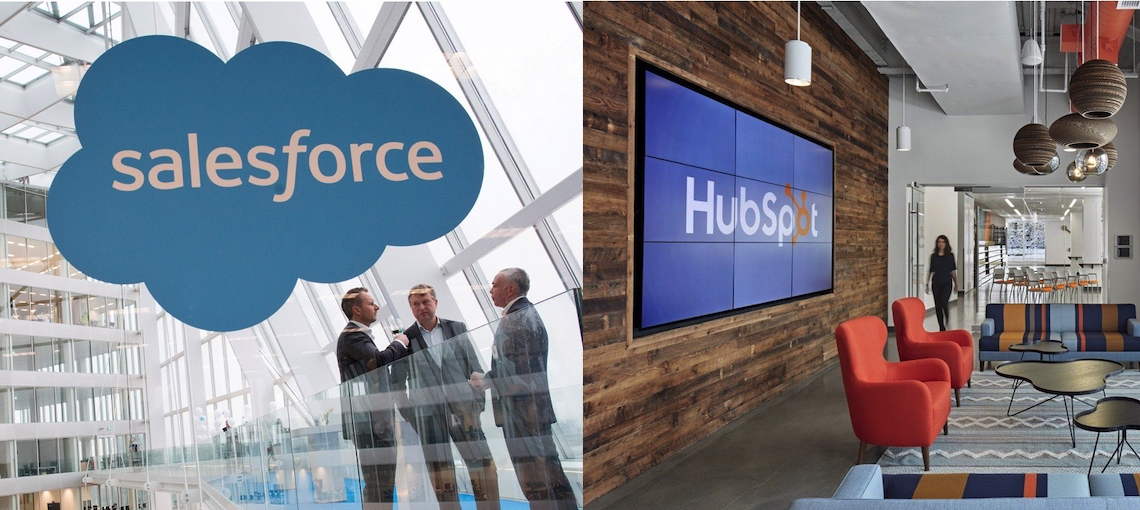
A Brief Summary of HubSpot and Salesforce
- Salesforce is the king of the CRM mountain, and the fastest growing company in the sector, in terms of revenue. Their name has become a bit of a genericized trademark along the lines of Band-Aid or Kleenex .
- HubSpot has quickly become the next most uttered name in the CRM discussion, having carved out a niche for themselves by serving the needs of smaller and/or younger businesses and sales teams.
- HubSpot offers a surprisingly robust, free version of their platform. Easy to use, and minimally disruptive to a team’s existing workflow. HubSpot is ideal for those new to CRM, and/or those who feel underserved by their current systems and are looking to branch out.
- The two companies, for the most part, respect and acknowledge the other’s distinctive functions, and don’t operate as direct competitors. HubSpot , in fact, touts easy integration with Salesforce as one of its strengths .
- HubSpot does, however, offer expanded, premium versions of their platform’s features. Contrasting with Salesforce ’s annual subscription packages, HubSpot employs a feature-by-feature, cafeteria-style pricing model.
An Explanation of the Insights Below:
The index scores in this entry (the numbers styled as 0.00x in the charts) quantify the extent to which the corresponding percentage is in excess of, is in line with, or falls short of the baseline.
For this study, the baseline is the average degree to which a piece of demographic info, an affinity, a habit, a personality trait, a fondness for a work of media/media property, or membership in a Digital Tribe is detectable among the entirety of Americans online.
By looking at the strongest interests among Salesforce’s and HubSpot’s most dedicated customers, one begins to detect that each platform more commonly lands within the purview of different departments.
While each platform can count those with an interest in both technological and explicitly business-related matters among their top customers, the audiences decidedly lean one way or the other.

The top general interests among HubSpot ’s customers are advertising and marketing . The former is an interest i dentified among 23.55% of their users, a quantity exceeding the baseline by 13.27 times . Marketing is an interest shared by 87.52% of their customers, which exceeds the baseline by 10.38 times .
Reflective of the oft celebrated ease with which the platform can be used, control of HubSpot — within the workplaces of what our insights reveal to be a large number of their users — seems to very possibly rest in the hands of the non-I.T. staff. Being a CRM tool, naturally that most often would be those who work in sales and marketing.
As HubSpot is concerned with inbound marketing, lead generation, and sales, and is designed to be quickly adopted in a hassle-free way, it stands to reason that its most ardent stans are not those up to their elbows in software, systems, and code.

While an interest in business software is detectable among both groups of customers — as no doubt it would be — it is far and away the most dominant interest among the Salesforce audience. That interest is evident in over 85% of their users , a quantity exceeding our baseline by 65.33 times . Add to that the facts that their second most prominent interest is in data centers (a concern detectable among 11.33% of the group, a quantity exceeding our baseline by 8.31 time s), and that cloud computing occupies the thoughts of a segment 3 ⅘ times greater than what you find when looking at the entirety of Americans online , and, well…
Let’s just say that we find ourselves resisting the temptation to portray this as a “ jocks vs. the nerds ” type scenario. We’ve sworn, however, to forgo any and all such metaphors unless and until “ rockers vs. the mods ” can reasonably be used. Clearly, that is not the case yet.
In truth, though, Salesforce is a considerably more sophisticated platform with a whole battery of functions, potentially extending into all areas of an enterprise. Conversely, HubSpot have positioned their platform as being easy enough to use that a company with no I.T. department of which to speak could still hit the ground running, using it in no time.
BOTH platforms are used by sales and marketing, as should go without saying, and our findings do support this. But there’s a fair bit more know-how required to get the most out of Salesforce. It stands to reason that the common concerns of those who work both with and in I.T. (i.e., those matters of a more techie nature) would rise to the top.
Behold the general interest numbers in chart form:
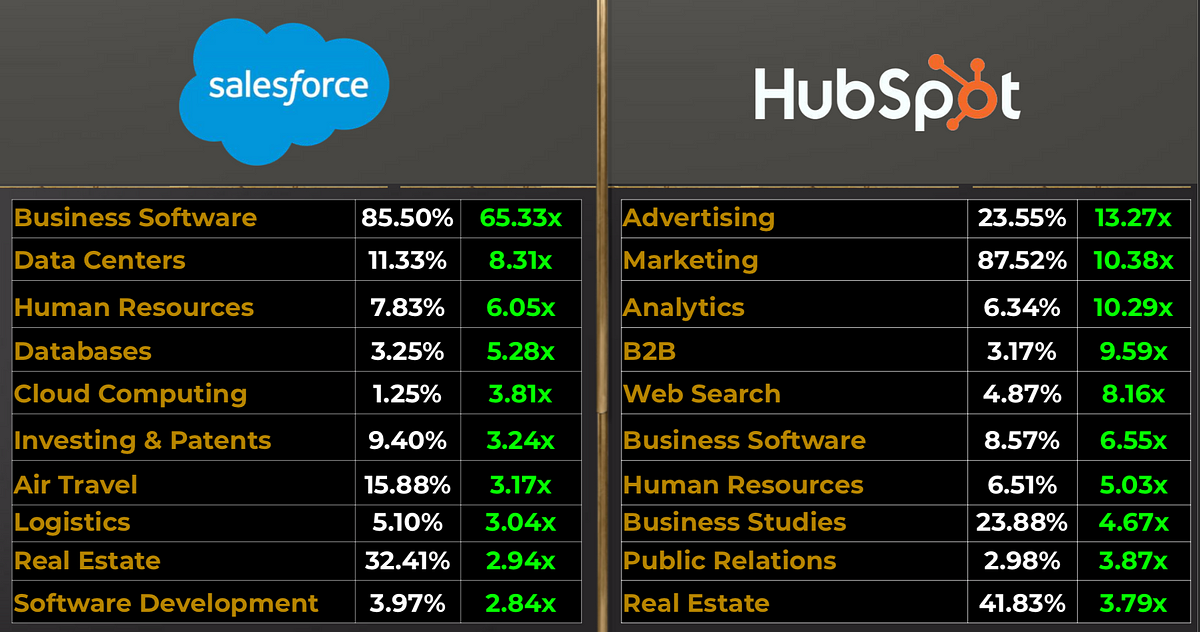
HubSpot’s usefulness as a free, or inexpensive, enhancement to other marketing automation and management platforms is directly reflected in their users’ favorite business software brands.

Marketo, and their toolkit of “complete Engagement Marketing Solutions ” ranks highest of all business softwares favored by HubSpot ’s customers. A quite significant 10.54% of their customer-base also belongs to that of Marketo . This percentage exceeds the baseline by a rather dramatic 66.87 times .

Oracle’s marketing automation platform, Eloqua is also a favorite among the HubSpot crowd, with the portion of their audience adopting the service exceeding the baseline by 37.68 times .
Salesforce’s customers, on the other hand, prefer to keep their solutions close-to-home before looking elsewhere.
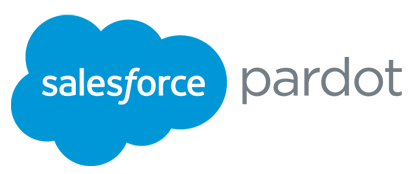
HubSpot integrates easily and well with Salesforce, and provides an affordable means of enhancing the latter’s features. But the business software most dramatically finding favor among Salesforce ’s users is the company’s own Pardot . The segment of their audience who identifies as using their homegrown marketing automation platform exceeds the baseline by 52.20 times .
Dipping a fair bit in terms of the degree to which it over-indexes against our baseline is the second most favored business software among Salesforce ’s customers, the Dell Technologie s owned, cloud computing, virtualization platform, VMware . Its users can be found among the CRM giant’s customers to a degree exceeding the baseline by 6.56 times .
For quick and easy reference, here are the business software affinity stats for these audiences, displayed graphically.
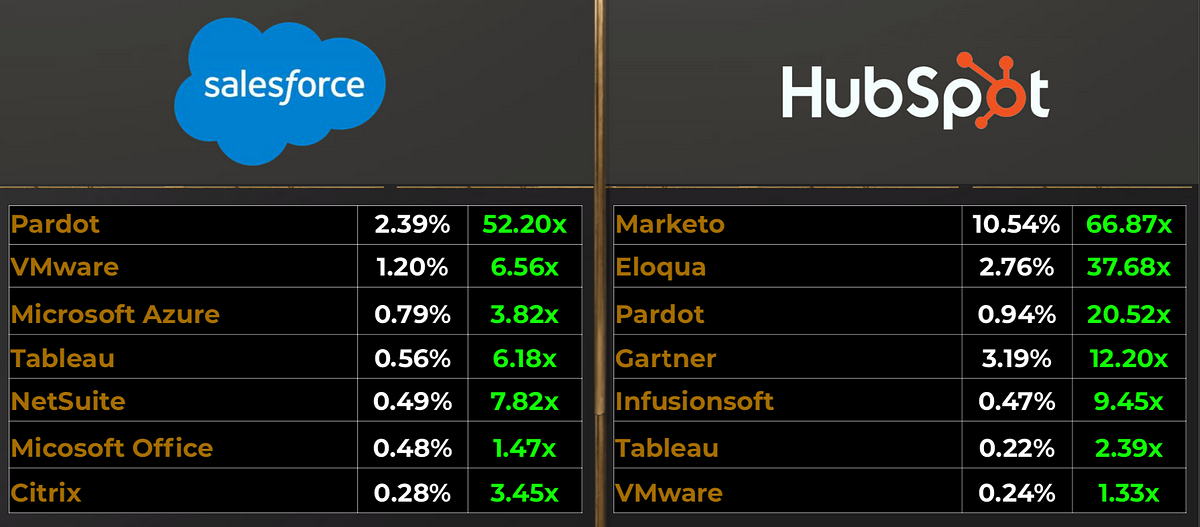
Those marketing mods of HubSpot , once more, face off against the rockers of Salesforce .
By looking at the non-business-software brands rating most highly with the customers of each platform, a tale as old as — well, at least as old as the start of this entry, but truthfully quite a bit older than that — again reveals itself.

Tech-oriented market research firm, Forrester Research , can boast that 7.83% of HubSpot ’s crowd are their customers & readers ( a proportion 24.85 times greater than what’s found when observing U.S. netizens as a whole) . Even more telling, the industry best-practices oriented, American Marketing Association, finds enthusiasts among this crowd to an extent 24.37 times in excess of our baseline.
And those techie types, maintaining and applying Salesforce’s considerable capabilities to the needs of their workplaces, make themselves quite known when observing their favorite non-business-software brands.

The top brands with the Salesforce bunch is a bit of a who’s who of tech-giants: Oracle, IBM, Microsoft , and Intel all pop up. But check it out for yourselves below.
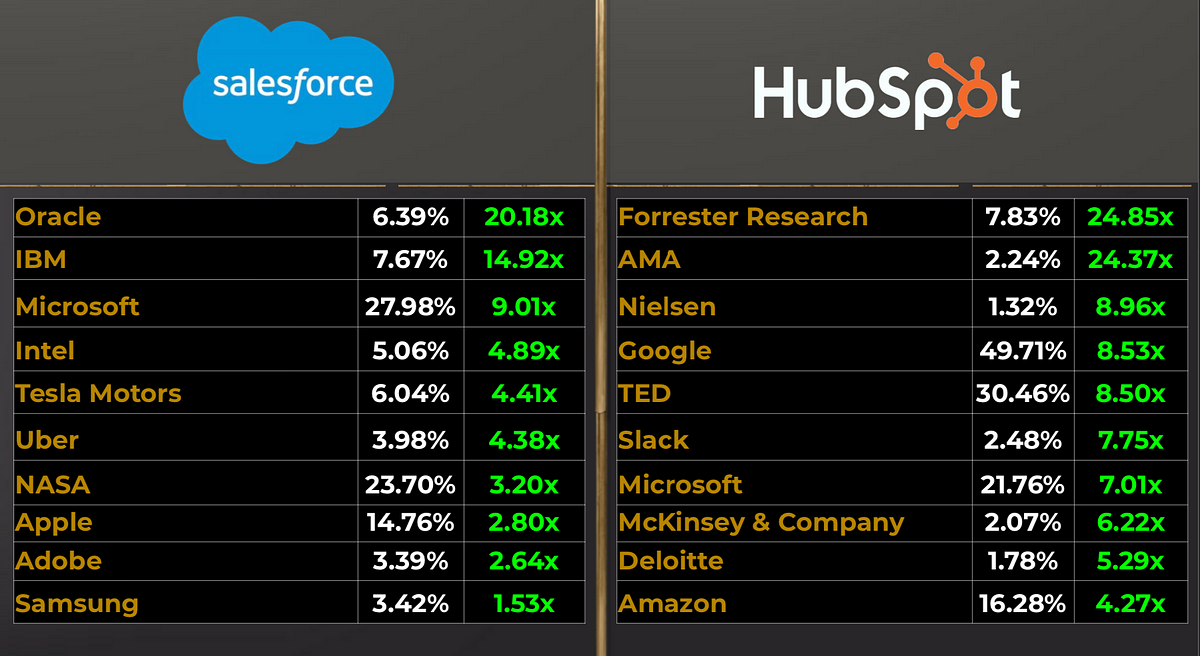
Statistics are unconcerned with your — or our — narratives. Alas, if only anything could be so neatly summarized as the jocks and nerds of popular fiction.
On the other hand, when perusing the popular media consumed by these groups, one side of this equation does still present a bit more, shall we say, cerebral.
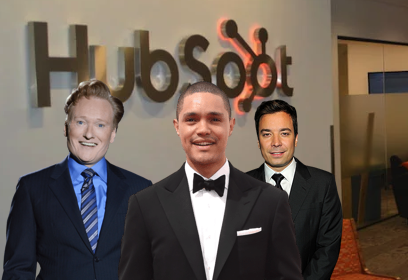
The movers and shakers populating HubSpot ’s gang of most dedicated customers enjoy their television, primarily, as it exists later in the evening (perhaps after a hard day at work, selling stuff, using HubSpot all the while).
Of TV’s offerings, Comedy Central ’s ‘ The Daily Show with Trevor Noah ’ is most prominent here, appealing to 12.39% of HubSpot ’s users ( a quantity exceeding the baseline by 2.70 times ). Next on their list are ‘ Conan ,’ and ‘ The Tonight Show Starring Jimmy Fallon. ’
The true nature of this group, though, shines through brightly upon noticing that the top podcast with this audience, Social Media Examiner ’s ‘ Social Media Marketing Podcast .’ It counts 2.85% of HubSpot’ s customers as listeners, a quantity that exceeds our baseline by a considerable 15.98 times .

Venturing over to YouTube : the Charisma on Command channel shares with viewers analytical breakdowns of various figures from current events and popular media. The channel provides analysis and insight into what it is that makes these figures charismatic, or conversely where they’ve not quite adequately accessed their powers to attract and influence (matters of natural interest to those in sales and marketing). It is viewed by a portion of HubSpot ’s audience that exceeds the baseline by 18.03 times .
“ But what, ” you may be asking, “ of Salesforce’s customers? ”
And you’re right to ask.
The top TV programs with the Salesforce crew are not, as lists featured in this entry up until now might suggest, explicitly tech related. They are, more so than not, at least in the upper reaches of their list, news programs. Big news broadcasts, some with roots extending nearly all the way back to the birth of the medium: ‘ CBS Evening News ,’ of which 11.91% of Salesforce ’s customers are viewers , a segment size 3.99 times greater than what you’d find among the U.S. online audience . 10.97% of this audience — a percentage exceeding the baseline by 3.17 times — regularly tunes into NBC ’s eternal ‘ TODAY. ’
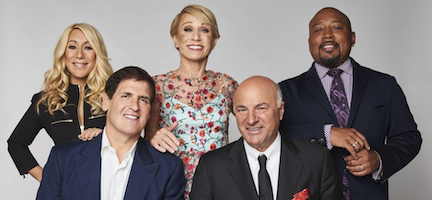
The top TV show, however, is arguably lighter fare, but also a bit more blatantly concerned with matters of a business nature. American TV’s monument to the entrepreneurial spirit, ‘ Shark Tank, ’ is the number one show with this gang. Having recently wrapped its 10th season, the show is a favorite with 13.36% of the Salesforce audience . This quantity exceeds the U.S. average by 9.70 times our baseline .
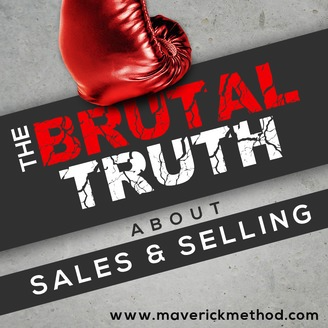
The highest ranking media here continues to drift a bit from the I.T. orientation of some categories outlined above, and instead — particularly when it comes to favorite podcasts — sticks closely to the first syllable of the platform’s name. ‘ The Brutal Truth About Sales & Selling ’ is a podcast that caters to the “ 2B Social SaaStr Cold Calling SaaS Salesman Advanced Hacker ” listener. The group of the Salesforce customer-base that are its fans are 6.77 times larger than what you’d find among the average U.S. online audience .

YouTube ’s ‘ The School of Life ,’ a 4.7 million subscriber “ channel devoted to self-knowledge and fulfillment ” is the favorite on the platform among this audience. It finds fans here to a degree greater than the baseline by 4.46 times .
And the top 5 TV shows with each audience are…
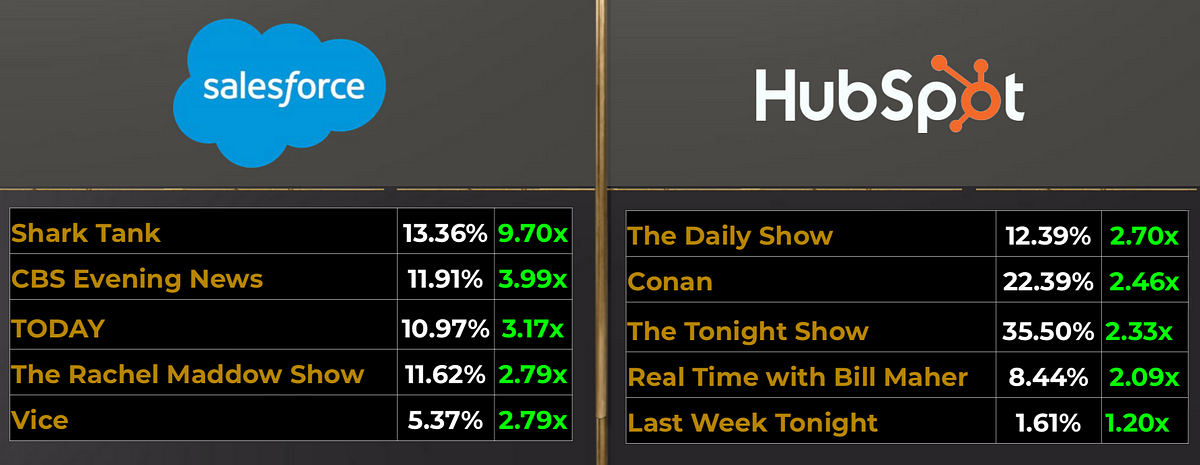
When looking in to which of our Digital Tribes the members of each platform’s customer-base belongs, and in what proportions, nothing arises which dispels a “sales and marketing to the HubSpot side, and techies to the Salesforce” type narrative.
StatSocial Digital Tribes is a model of the U.S. population broken down into 100 distinct market segments ( calculated by combining our demographic and affinity data with our Personality Insights ® data; the latter powered by IBM Watson ). Seeing which Tribes are present, and in what proportions, grants our users quick, crucial, and unprecedented insight into the humans who make up a given audience.
You can read more in depth descriptions of the Tribes mentioned below here , and you can read a blog entry going into the whole Digital Tribes matter a great deal more in-depth here .
The graphics below show the 10 best represented Tribes among each of the audiences being explored. An ever-so-pithy summary of the shared affinities, demographics, and/or personalities of each tribe is then provided. But again, we recommend you check out the more in-depth (albeit still brief) descriptions here , where you’ll find descriptions of the other Digital Tribes as well.
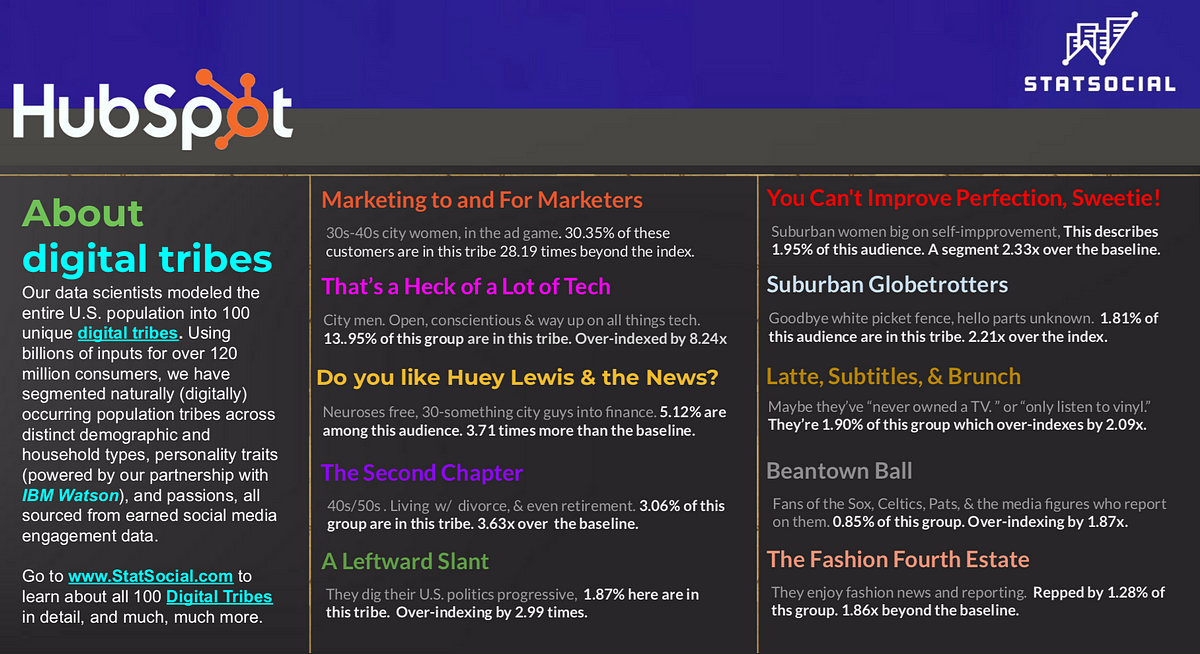
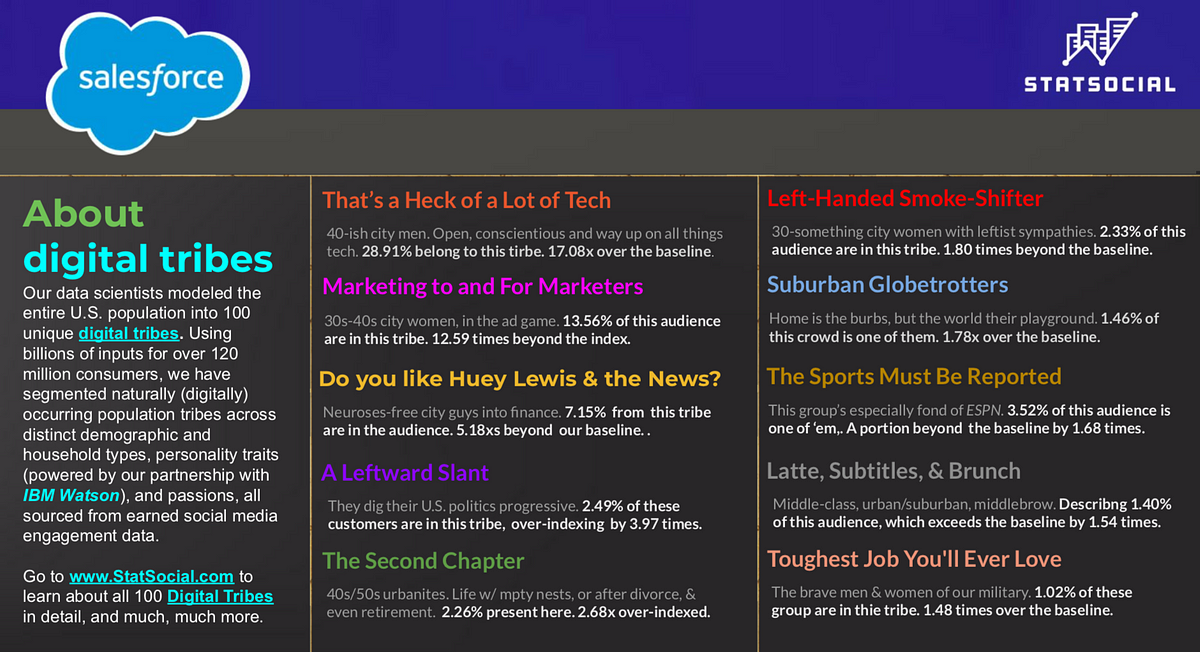
The comparisons above say as much about who is within each of these groups of customers as any featured in this entry. These are, of course, the top, most over-indexed results. Deeper digging — and please reach out to us for a demo , so we can show you just what that might entail — will reveal only finer detail, and reveal all the more subtle differences between the two groups.
Both platforms central to the workdays of those in sales and marketing, as well as those in I.T., and other tech-related positions within a company. The platform designed to be most easy-to-use and quick-to-adopt finds non-tech-sorts — or, more accurately interests and affinities — the most prominent among its audience. Conversely, the more robust, sophisticated, and all-encompassing platform requires I.T. for maintenance, scaling, customizing, and integration, with its fullest potential being realized by tech savvy sales and marketing sorts.
Most immediately telling — and of course confirming the basic narrative set out from the start — is that the Digital Tribe best represented among HubSpot ’s customers is “ Marketing to and For Marketers ” (the name being rather self-explanatory), and the second most prominent is “ That’s a Heck of a Lot of Tech ” (same).
And of course, among the Salesforce crowd, the top two most prominent tribes are flipped.
BONUS
Usually we open with demographics, but here they make a nice epilogue.
While very important, and the bear minimum of what any reasonable customer would expect from an analytics platform such as ours, for the purposes of this entry, they weren’t necessary for demonstrating our ability to reveal the differences between audiences many would assume to be more or less statistically the same.
But you do want to know the demographics, right? Well, here they are:
GENDER

The gender split among the HubSpot audience being much closer to even is unsurprising, if the interpretations of the data up to this point have been accurate. Without involving ourselves in the greater discussion (except to say that there’s no reason for there to not be as many women as men in every field, and at every level; an opinion of ours we hope would be taken for granted), it is rather well-accepted that, whatever the reasons, women are historically under represented in I.T. roles, whereas they are some of the biggest names in sales and marketing.
INCOME
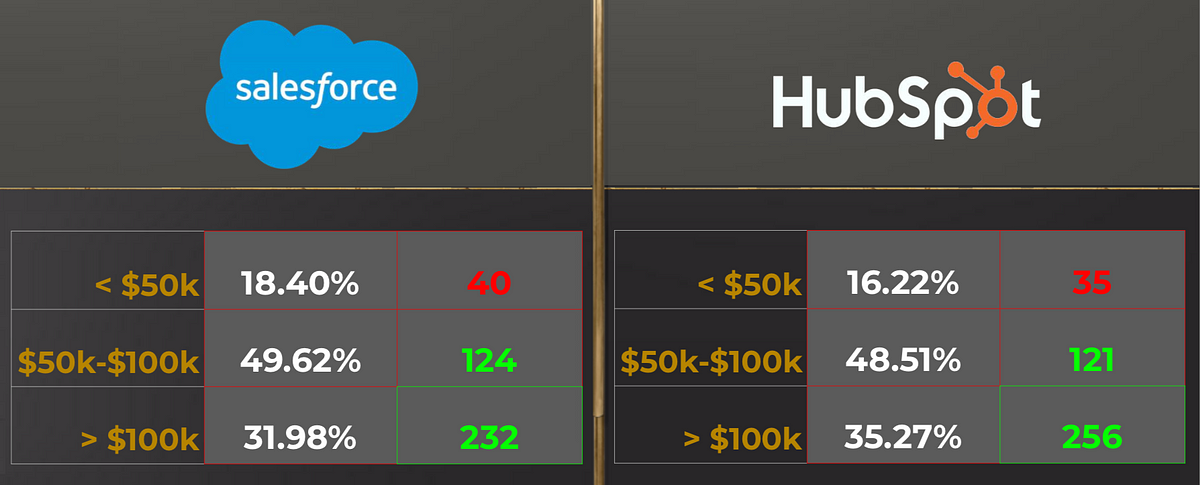
In an overall way, these are two audiences who both earn extremely well, with over a third of the HubSpot audience earning over 100k a year. These are the kinds of customer statistics any enterprise platform would be pleased to see.
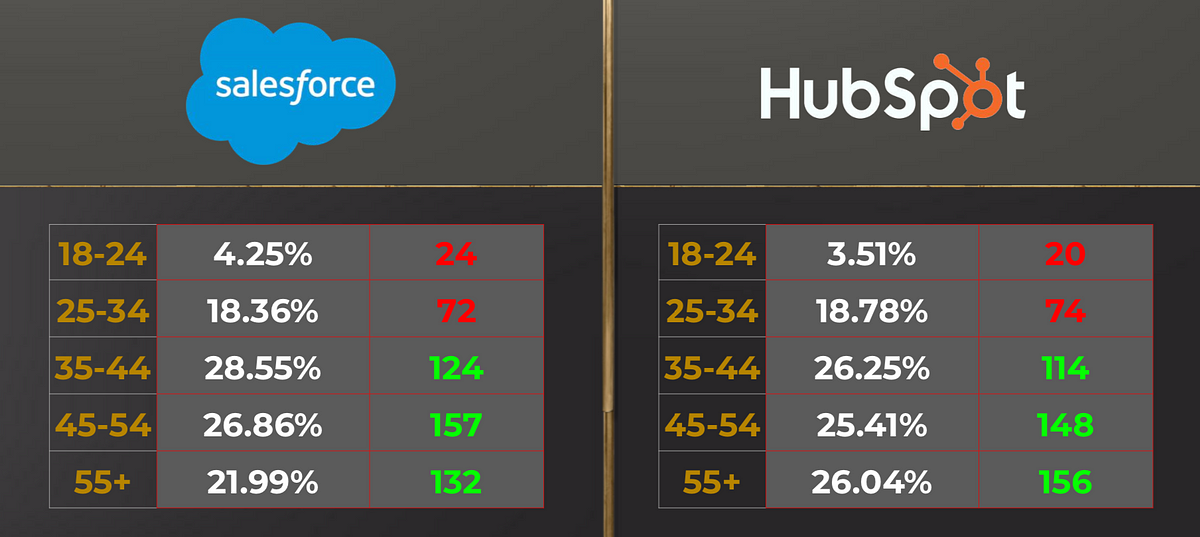
Both of these audiences skew older in comparison to our baseline of the entire U.S. online population. Those over age 55 are impressively well-represented, and account for over a quarter of HubSpot ’s audience.
While the under-34 set fall below the baseline, they do still account for over one-fifth of each group of customers.
— — — — — — —
Take a Sniff Around
If you are interested in digging into the raw data behind this report, let’s schedule a time to chat .
More information on StatSocial data can be found here .
More information on StatSocial solutions can be found here:
Insights on top of insights can be found by the curious reader who chooses to poke around the StatSocial blog here . Peruse the many entries, offering all kinds of insights, studies, and deep dives to better acquaint you with the capabilities of StatSocial .
To learn more or request a demo, click here .